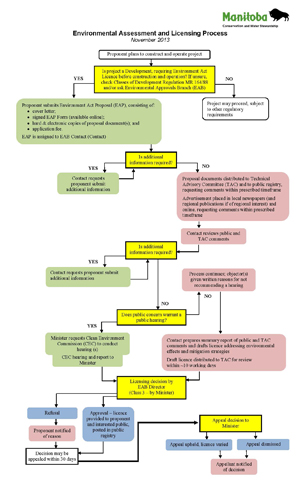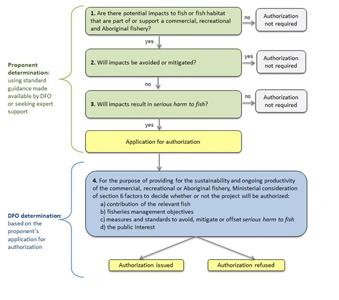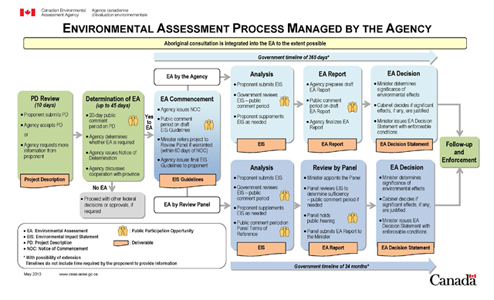Environmental
Environmental Assessment Process
Environmental assessment is a process to predict environmental effects of proposed initiatives before they are carried out.
As defined on the Impact Assessment Agency of Canada website, an environmental assessment:
- identifies potential adverse environmental effects
- proposes measures to mitigate adverse environmental effects
- predicts whether there will be significant adverse environmental effects, after mitigation measures are implemented
- includes a follow-up program to verify the accuracy of the environmental assessment and the effectiveness of the mitigation measures
These activities identify environmental, social and economic factors that should be considered during the construction process. More information on the sequence of construction for the proposed Project is available here: Construction Sequencing Overview – 2023
Environmental Impact Statement (EIS)
Manitoba Infrastructure is pleased to publicly share the EIS for the Lake Manitoba and Lake St. Martin Outlet Channels Project. The EIS describes the project, assesses potential effects, and identifies how these effects will be addressed. The EIS is available online at the following websites for Indigenous groups and communities; the general public; and stakeholders to provide feedback on Manitoba Infrastructure's environmental assessment and proposed mitigation and monitoring programs:
- Canadian Impact Assessment Registry
https://www.iaac-aeic.gc.ca/050/evaluations/proj/80148 - Manitoba Conservation and Climate Public Registry
https://www.gov.mb.ca/sd/eal/registries/index.html
The following summary documents have been prepared to outline key information from the EIS:
|
The following narrated presentation was also prepared to describe the environmental assessment that was undertaken for the Lake Manitoba and Lake St. Martin Outlet Channels Project:
Environmental Assessment Summary
Environmental Management Plans
Manitoba Transportation and Infrastructure drafted environmental management and monitoring plans for the proposed Lake Manitoba and Lake St. Martin Outlet Channels Project as part of the provincial and federal environmental assessment process.
The plans propose steps to measure and monitor the activities and potential impacts of the proposed project. They include what we will be doing during both the construction and operation phases of the proposed project. We shared the previous drafts of these plans in three sets over November and December of 2020. The intent was to provide summaries of each plan and provide opportunities for feedback on the adequacy, contents, clarity, and methodology of each plan.
Due to the effects of the COVID-19 pandemic on in-person meeting requirements, some outreach had to be conducted through virtual meetings, a virtual engagement portal, EngageMB (November 16, 2020 to January 14, 2021), virtual open houses, and website updates. We also provided printed or electronic (e-mail) copies where needed.
While the virtual portal is now closed, the previous versions of the plans are still available.
The documents below are the current versions of Manitoba Transportation and Infrastructure’s environmental management and monitoring plans as of January 2023.
- Access Management Plan v.2
- Agricultural Biosecurity Management Plan v.2
- Aquatic Effects Monitoring Plan v.2
- Complaints Resolution Process v.2
- Construction Environmental Management Plan v.2
- Dust Control Plan v.2
- Eastern Whip-poor-will Habitat Plan v.2
- Environmental Management Plan Framework v.2
- Environmental Protection Plan v.2
- Groundwater Management Plan v.2
- Heritage Resources Protection Plan v.2
- Ice Management Plan v.2
- Operational Environmental Management Plan v.2
- Project Environmental Requirements v.2
- Quarry Management Plan v.2
- Red Headed Woodpecker Mitigation Plan v.2
- Revegetation Management Plan v.2
- Sediment Management Plan v.2
- Site Decommissioning Plan v.2
- Surface Water Management Plan v.2
- Wetland Compensation Plan v.2
- Wetland Monitoring Plan v.2
- Wildlife Monitoring Plan v.2
Archived Environmental Management Plans
Environmental approvals
Federal and provincial environmental approvals are required for the Lake Manitoba and Lake St. Martin outlet channel project.
Environmental Licences are granted from government agencies that are the responsible authority for The Environment Act, The Fisheries Act, and The Canadian Environmental Assessment Act.
These include:
- Manitoba Conservation and Climate – Environmental Approvals Branch
- Impact Assessment Agency of Canada (IAAC)
- Fisheries and Oceans Canada (DFO)
Manitoba environmental approvals

Manitoba Conservation and Climate Environmental Approvals Branch is responsible for administering the requirements of The Environment Act.
The Environment Act outlines the environmental assessment and licensing process for developments in Manitoba that may have potential for environmental and / or human health effects. The process exists to ensure environmental and human health protection, encourages early consultation, allow for full public participation, and ensure economic development occurs in an environmentally responsible manner.
Required approvals:
- The Environment Act Proposal for the proposed Interim Operation of the Lake St. Martin emergency outlet channel
- The Environment Act Proposal for construction of the all-season road that will provide access to the Lake St. Martin emergency outlet channel
- The Environment Act Proposal for the permanent Lake Manitoba and Lake St. Martin outlet channels project
External links
- Environmental Approvals Branch - https://www.gov.mb.ca/sd/eal/registries/5865lstmartin/index.html
- Public Registry - https://www.gov.mb.ca/sd/eal/index.html
- Lake Manitoba Lake St. Martin Project Registry - https://www.gov.mb.ca/sd/eal/registries/5966lstmartin/index.html
Impact Assessment Agency of Canada (IAAC)
IAAC ensures that the environmental assessment of the Lake Manitoba and Lake St. Martin Outlet Channels Project is conducted in accordance with the Canadian Environmental Assessment Act, 2012 (CEAA 2012).
The purpose of CEAA 2012 is to protect components of the environment that are within federal legislative authority from significant adverse environmental effects caused by a designated project.
CEAA 2012 applies to project described in the Regulations Designating Physical Activities and to projects designated by the Minister of the Environment.
Required approvals:
- IAAC Licence for the Lake Manitoba and Lake St. Martin Outlet Channel Project
Public participation is encouraged at various stages during the environmental assessment process. Check out the link below for more information about the Impact Assessment Agency.
External links
- Information on the IAAC Process: https://www.canada.ca/en/impact-assessment-agency/services/policy-guidance/impact-assessment-process-overview.html
- Canadian Impact Assessment Registry: https://www.iaac-aeic.gc.ca/050/evaluations/proj/80148
Fisheries and Oceans Canada (DFO)

Fisheries Protection Provisions which focus on the management of threats to the sustainability and productivity of commercial, recreational and Aboriginal fisheries or to fish that support such a fishery.
The Lake Manitoba and Lake St. Martin outlet channel project will be submitting an Application for Authorization under Paragraph 35(2)(b) of The Fisheries Act Regulations.
The Authorization includes terms and conditions the proponent must follow to avoid, mitigate, offset, and monitor the serious harm to fish resulting from the project.
External links
- Fisheries Protection Policy Statement - https://www.dfo-mpo.gc.ca/pnw-ppe/policy-politique-eng.html



